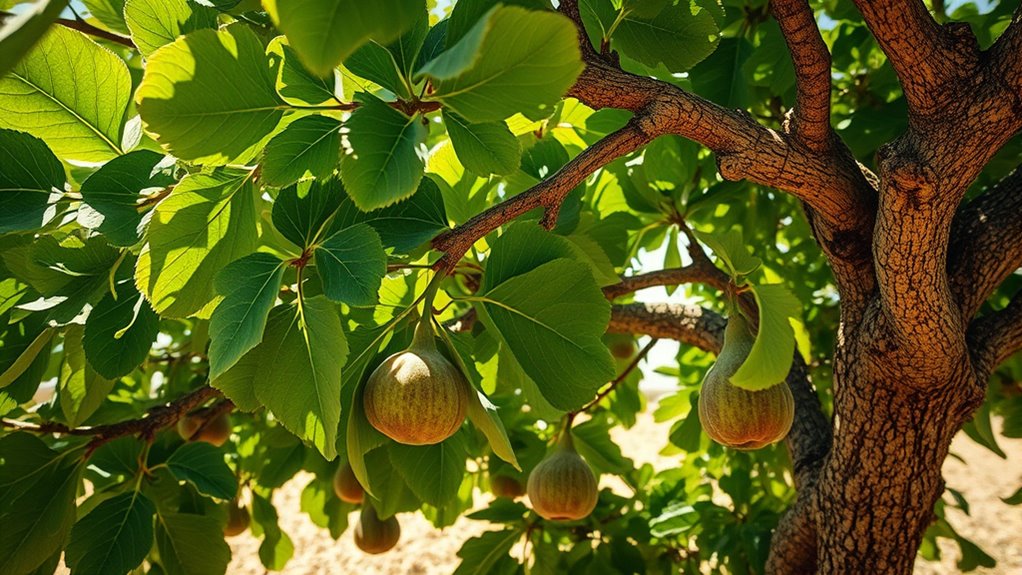Jesus cursed the fig tree to symbolize spiritual fruitlessness and expose hypocrisy. In ancient Israel, fig trees represented prosperity and divine blessing, but when Jesus found a tree with no fruit, he used it as a powerful lesson. It reminds you that outward appearances don’t matter without genuine faith and devotion. If you look closer, you’ll uncover deeper meanings behind this act and how it relates to authentic faith today.
Key Takeaways
- Jesus cursed the barren fig tree to symbolize judgment against spiritual fruitlessness and hypocrisy.
- The fig tree represented prosperity and divine blessing, making its failure to bear fruit significant.
- The act used symbolism to teach about faith, readiness, and the importance of genuine devotion.
- It highlighted the contrast between outward religious appearances and true inner faith.
- The curse serves as a lesson for believers to cultivate authentic faith and spiritual fruitfulness.
The Biblical Account of the Cursing

The biblical account of Jesus cursing the fig tree appears in Matthew 21:18-22 and Mark 11:12-14, 20-21. In these passages, Jesus approaches a barren fig tree expecting fruit, but finds none. He then curses it, and the tree withers immediately, illustrating a powerful act tied to fig tree symbolism. This event is often viewed as a biblical curse, symbolizing judgment against fruitlessness and hypocrisy. The story emphasizes that outward appearances, such as a lush-looking tree without fruit, are meaningless in spiritual terms. Jesus’s actions serve as a reminder that true faith and righteousness must produce fruit. This account’s vivid imagery and biblical curses highlight the importance of genuine spiritual productivity over superficial appearances.
The Cultural Significance of Fig Trees in Ancient Israel

Fig trees held deep cultural and symbolic meaning in ancient Israel, serving as more than just a source of food. They played a central role in agricultural practices, often representing prosperity and divine blessing. Farmers valued fig trees for their reliable yield and their ability to thrive in local climates, making them essential for sustenance. Beyond practical use, fig trees held folklore significance, symbolizing peace, abundance, and connection to God. They appeared in stories and proverbs, emphasizing themes of growth and fertility. This cultural reverence meant that the presence or absence of a fig tree could carry spiritual connotations, influencing social and religious perspectives. Understanding these cultural and folklore associations helps explain the deeper implications behind Jesus’ actions concerning the fig tree.
Jesus’ Use of Symbolism in His Teachings

Jesus often uses symbolism in his parables to communicate deeper spiritual truths. When you interpret these stories, you see how he conveys messages beyond the literal meaning. Recognizing these symbols helps you understand his teachings more clearly.
Symbolism in Parables
Symbolism plays a vital role in Jesus’ parables, as it allows him to convey profound spiritual truths through familiar images and stories. In biblical parables, he often uses symbols like the fig tree to illustrate lessons about faith, judgment, and readiness. Fig tree symbolism is common because it was well-known in the region and held significance in Jewish culture. When Jesus uses a fig tree in his teachings, he invites you to see beyond the literal and grasp the deeper message. These biblical parables use symbolic language to communicate complex truths simply and memorably. By understanding the symbolism behind the fig tree, you gain insight into spiritual principles that Jesus aimed to teach, making his messages both meaningful and accessible.
Conveying Spiritual Messages
Because stories and images are easier to remember than abstract concepts, Jesus often used symbolism to communicate spiritual truths effectively. Fruit symbolism is a powerful tool he employed, turning everyday objects into lessons about faith and righteousness. For example, the fig tree’s failure to bear fruit became a prophetic act illustrating spiritual unfruitfulness and judgment. Jesus used these symbolic acts to convey deeper messages without lengthy explanations, making them memorable and impactful. By performing prophetic acts, he demonstrated the consequences of spiritual neglect and emphasized the importance of genuine faith. Your understanding deepens when you see these acts as more than literal events—they’re deliberate symbols meant to inspire reflection and transformation. This method guarantees his teachings resonate beyond words, leaving a lasting spiritual impression.
The Context of Religious Hypocrisy

The episode with the fig tree occurs within a broader pattern of religious hypocrisy that Jesus frequently confronted. During this time, many religious leaders prioritized outward appearances over genuine faith, often focusing on ritualistic practices like sacrificial offerings and temple rituals. They emphasized following customs publicly while neglecting true justice and mercy. Jesus saw through these superficial displays, criticizing leaders who maintained strict outward observance but lacked authentic devotion. The fig tree’s curse symbolizes this disconnect—appearing fruitful but being barren inside. Similarly, religious leaders emphasized rituals without transforming their hearts. Jesus’s actions highlight that true faith isn’t just about external actions but about the sincerity behind them, exposing the hypocrisy that undermines the spirit of true worship.
The Message of Faith and Fruitfulness

The story of the cursed fig tree conveys a powerful message about faith and fruitfulness, reminding you that genuine belief should produce visible results. Your faith growth isn’t just about belief; it’s about demonstrating trust through action and spiritual discipline. When you nurture your faith, it should lead to tangible outcomes—fruit in your life that reflects your connection with God. Jesus’s act shows that a lack of spiritual fruitfulness signals a disconnect from true faith. To honor this message, you must cultivate your faith intentionally, practicing spiritual discipline daily. This ongoing effort strengthens your trust in God’s power, enabling your faith to flourish and produce the fruits that testify to your commitment and spiritual health.
The Event as a Prophetic Act

Viewing Jesus’ curse of the fig tree as a prophetic act reveals its deeper significance beyond a simple miracle or warning. It symbolizes divine judgment on unfruitful Israel, highlighting their spiritual barrenness. This event isn’t just about the tree; it’s a dramatic illustration of what’s to come. Consider these key points:
- It anticipates the miraculous healing of faith, showing that spiritual renewal is possible but requires true fruitfulness.
- The act underscores divine judgment against hypocrisy, where outward appearances mask internal emptiness.
- Jesus’ actions serve as a prophetic warning that spiritual fruitfulness is essential, or else divine judgment will follow.
This event functions as a powerful, symbolic act that communicates God’s expectations and impending judgment.
Lessons for Modern Believers

Jesus’ prophetic act of cursing the fig tree offers a powerful lesson for modern believers about the importance of genuine faith and spiritual authenticity. It reminds you that empty rituals or superficial religiosity won’t satisfy God’s desire for true devotion. When you practice modern prayer and spiritual discipline, focus on cultivating a sincere connection with God rather than going through the motions. Authentic faith requires consistent effort and a heart committed to growth. The fig tree’s curse warns against hypocrisy and insincerity, urging you to evaluate the motives behind your spiritual practices. By embracing genuine faith and living out your beliefs authentically, you deepen your relationship with God and reflect His love more effectively in everyday life.
Frequently Asked Questions
What Is the Deeper Spiritual Meaning Behind Jesus Cursing the Fig Tree?
When you consider the deeper spiritual meaning behind Jesus cursing the fig tree, you see it as a faith symbolism and a warning about spiritual judgment. Jesus uses the fig tree to symbolize those who appear fruitful but lack true faith. This act urges you to examine your own spiritual health, emphasizing that outward appearances aren’t enough; genuine faith is essential for growth and righteousness.
How Does This Event Relate to Jesus’ Overall Ministry and Teachings?
You see, this event highlights how Jesus’ ministry centers on faith symbolism and divine judgment. By cursing the fig tree, he emphasizes the importance of genuine faith and spiritual fruitfulness. It reminds you that outward appearances don’t cut it; true devotion matters. This act aligns with his teachings, warning that spiritual complacency invites judgment and urging you to stay rooted in authentic faith and active service.
Did Jesus’ Action Have Any Immediate Impact on the Fig Tree Itself?
You might wonder if Jesus’ curse of the fig tree had an immediate effect on it. The answer is no; the tree showed no visible change right away. This act symbolizes fruitless symbolism, illustrating spiritual barrenness. While the tree appeared unaffected immediately, the curse serves as a warning about empty faith and the importance of genuine spiritual growth, emphasizing that actions often have long-term significance rather than immediate results.
Are There Parallels Between This Story and Other Biblical Stories Involving Trees?
Imagine a garden where trees whisper stories of life and judgment. You see parallels in biblical stories like the Tree of Life and the cursed fig tree, both embodying fruit symbolism and tree allegories. These stories serve as powerful lessons about growth, righteousness, and divine judgment. Just as a tree’s fruit reveals its nature, these biblical tales remind you that spiritual health reflects outwardly, urging you to nurture faith and righteousness.
How Do Different Christian Denominations Interpret This Incident Today?
You’ll find that different Christian denominations interpret this incident through their faith practices and doctrinal differences. Some see it as a metaphor for spiritual fruitfulness, emphasizing faith and prayer, while others view it as a lesson on judgment and repentance. These varied perspectives influence how believers apply the story today, shaping their understanding of Jesus’ teachings and encouraging reflection on personal growth and spiritual discipline within their faith communities.
Conclusion
Think of the fig tree as a mirror of your faith—if you show no fruit, you’re missing the point of true growth. Jesus’ curse reminds you that appearances aren’t enough; genuine faith produces action. Just as a tree’s fruit reveals its health, your deeds reveal your heart. Let this story be a wake-up call: don’t settle for surface-level faith. Cultivate authenticity and let your life bear the fruit that reflects your inner belief.










